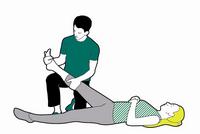(Under 1 Year)
An infant may readily choke on food or on very small objects in the mouth. The infant will rapidly become distressed, and you need to act quickly to clear any obstruction. If the infant becomes unconscious, be prepared to give rescue breaths and chest compressions. If an unconscious infant, the throat muscles may relax, leaving the airway sufficiently open for rescue breathing. If rescue breaths fail, chest compressions may clear the obstruction.
Recognition
- Ask the infant if he is choking.
- For mild obstruction, infant able to cough, but difficulty crying or making any other noise.
- For severe or complete obstruction, unable to make any noise or breathe, with eventual loss of consciousness.
| Photo Courtesy of Google |
Priorities
- To remove the obstruction.
- To arrange urgent removal to hospital if necessary.
Steps in administering aid
- If an infant is distressed, is unable to cry, cough, or breathe, lay him face down along your forearm, with his head low and support his chest and head. Give up to five back blows with the heel of your hand.
- If back blows fail to clear the obstruction, turn the infant on to his back and give up to five chest thrusts. Using two fingers, push inwards and upwards (towards the head) against the infant’s breastbone, one finger’s breadth below the nipple line.
- Perform five chest thrusts. The aim is to relieve the obstruction with each chest thrust rather than necessary doing all five. Check the mouth.
- If the obstruction is not cleared, repeat the above steps three times. If the obstruction is not cleared, take the infant with you to ambulance/medical aid. Continue until help arrives or the infant becomes unconscious.
| Photo Courtesy of Google |

